|
|
Expedition
Expedition | People
|
Log - August-15-2003
by Gerhard Behrens and Robert McCarthy
Previous | Next
“Time passes much too quickly”
“Does anybody really know what time it is?”
“What a long strange trip it’s been”
Robert McCarthy |
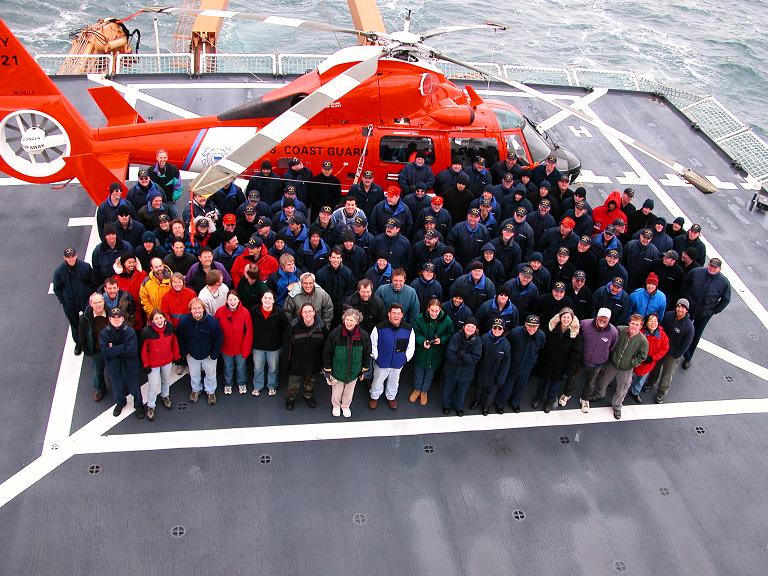 |
Well, this is it---my last log entry from the Healy. And a lot has happened that I am eternally grateful of. The two wonderful side trips (the helo and the Healy 3), the beautiful scenery, and the lovely people I had the pleasure to get to know and spend a month with. Plus, spending time with my old friend Andreas brought me to think about time long past, and the “big-at-the-time” research cruises onboard the RV Cape Henlopen. Time does pass much too quickly! |
| “Does anybody really know what time it is?” Time is all relative to the observer. The twin paradox is a prime example of time being a personal concept relative to the observer who measures it. The story goes, that one of the identical twin brothers goes on a space flight traveling at nearly the speed of light. To his watch on his wrist, time doesn’t appear to change. There are still 60 seconds in a minute, and to his reference frame he can’t tell he’s moving. The other identical twin brother stays home here on earth. His watch too appears to him to behave perfectly. But when the space traveler brother returns home, he doesn’t recognize his twin brother. The traveler hasn’t appeared to age much while his twin is an old man. How can this be? Each watch behaved perfectly. Well, it turns out that time does slow down for an observer traveling at high speeds. This has been proven with atomic clocks that have been identically synchronized before a flight. One goes very high and fast relative to the one left on the ground. Upon return, it was shown that the clock on the ground gained time over the one in the air. Not a lot mind you, but measurable. This helped substantiate Einstein’s theory of Relativity. |
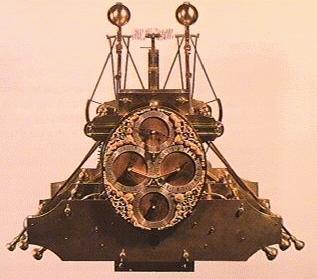 |
| And speaking of time, these last few weeks (since July 25th) the sun hasn’t set. So there is no external visual clue what time it is. That’s a good thing, since coming back from the Healy 3 at midnight the sun was still out. We had been gone for 6 hours, and it only felt like 2 hours. We were busy, and so much was going on, that time seamed to slow down for us. Had it got dark around 20:00, we would have been externally reminded how late it actually was. |
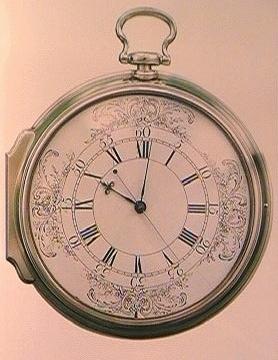 |
Since the sun appears to move around the earth in 24 hours and there are 360 degrees in a circle, then there are 15 degrees of longitude for every hour. This corresponds roughly to each time zone. Going across the country, from Delaware to Oregon, you gain 3 hours since you’re traveling in the same direction as the sun appears to move. The other way, you lose 3 hours. Early seafarers needed an accurate measure of time, so they could tell longitude correctly. If you look at very old maps, the landmasses are distorted. Latitude the sailors could get fairly accurately, from looking at stars or by using a sextant in the daytime. John Harrison in 1735 was the first person to make an accurate sea-clock (chronometer) to measure time while at sea (pendulum clocks don’t work due to the ship’s motion). His design had a balance spring with two 5-lb weights connected by brass arcs, see fig 1. This clock was reported to lose on 3 seconds in 24 hours. Later his 4th design, shown in fig 2, only lost 5 seconds in 2 months. Using these accurate sea-clocks, nautical maps became much more accurate. By recording the time on your local watch when the sun was at its highest in the sky, you could determine how many degrees of longitude (east or west) you traveled from home. For example, if you sailed from England west in the Atlantic Ocean, and measured the sun overhead at 14:00 hours, you would know that you had traveled 30 degrees of longitude to the west. If the sun were directly overhead when your clock measured 11:00 hours, you would know that you traveled 15 degrees of longitude to the east. |
| Looking at our ship track, you might think “What a long strange trip it’s been”. Long, yes, but all those turns and meanders were for a reason. A lot was accomplished on this cruise, and the scientists worked extremely well together. For the amount of different interests, (coring, clams, chemistry, moorings, CTD’s, ADCP’s, and bottom mapping,) and the 8 different institutions involved, Dr. Kelly Falkner did an excellent job appeasing everybody. This was no small feat! The weather and ice conditions helped, but she was an outstanding “Principal Investigator”. |
| To thank everyone individually here would be too much, but I enjoyed EVERYBODY’S company. Special thanks to my fellow teacher, Gerhard Behrens, for all of his help. His insights, his log journal, and his good note taking skills, helped my log reports become better. Plus, he’s the exercise guru, who kept me at it when the “rack” seemed like a better idea. Special thanks to Lauren Brown for putting up with me, and placing my stories on the web. She did an excellent job, and she deserves a lot of credit. Special thanks to Dr. Andreas Muenchow for contacting me with this awesome opportunity, and for talking about old-times. We had a lot of fun at the College of Marine Studies together, and his enthusiasm for oceanography has not waned a bit. I enjoy listening to his research ideas. And again, I thank Dr. Kelly Falkner for all the excursions I was on, and for giving me a “ride of a lifetime”. I experienced so much else, from learning about the Inuit people, to learning how to take better pictures, to seeing a coring operation, and to witness divers in the Arctic to name just a few. It’s been a wonderful month. |
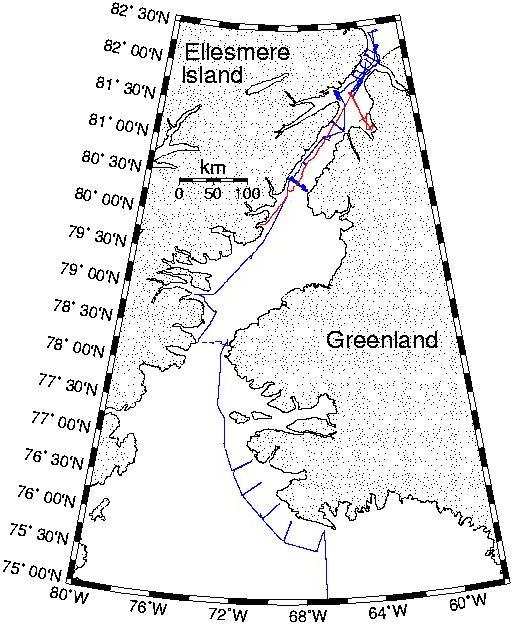 |
| Thank you to the crew of the USCGC Healy, who made this month very enjoyable. The accommodations were excellent, and the food amazing. The Captain runs a smooth ship, and he commands a lot of respect. He’s interested in the science, and goes out of his way to please the research team. Thanks, Captain Oliver! |
| And thanks to my family for supporting this undertaking. Their emails were the highlight to many a day. I anxiously await to be with them again. |
Report Card for CATS
Gerhard Behrens |
| Last day on the ship. Since I am a teacher, it must be time for a report card. That’s exactly what the chief scientist is doing. Kelly Falkner is busy finishing a report that tells about all the things that happened on the ship over the last four weeks. |
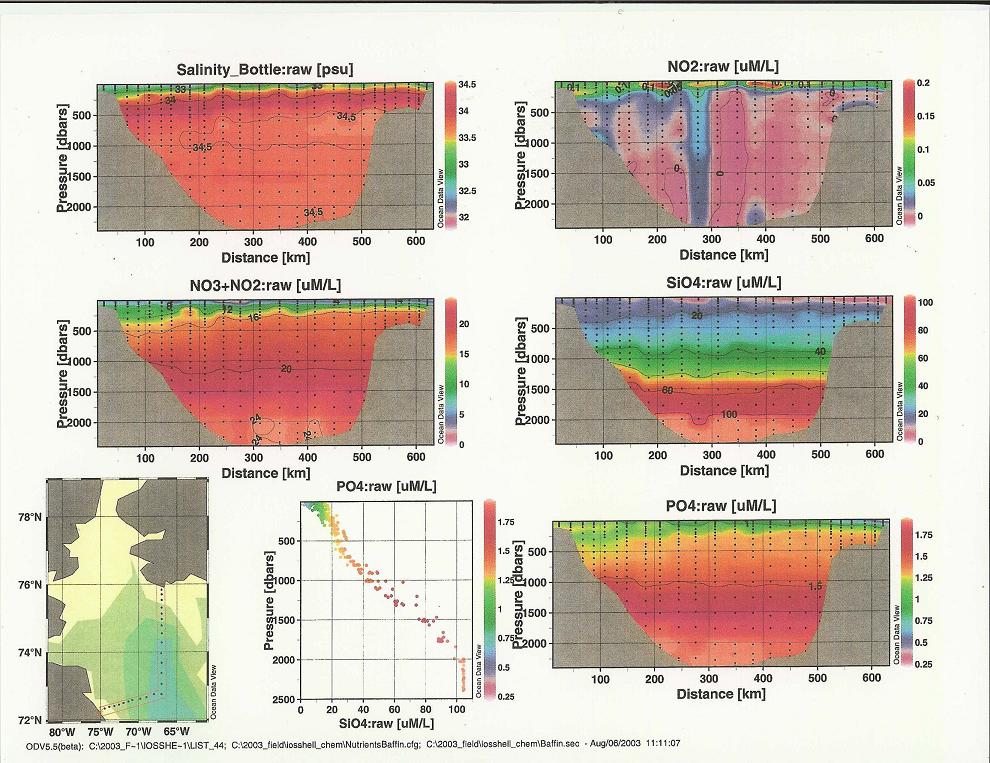
Water samples will provide lots of information; most of it will be in graphs and charts. |
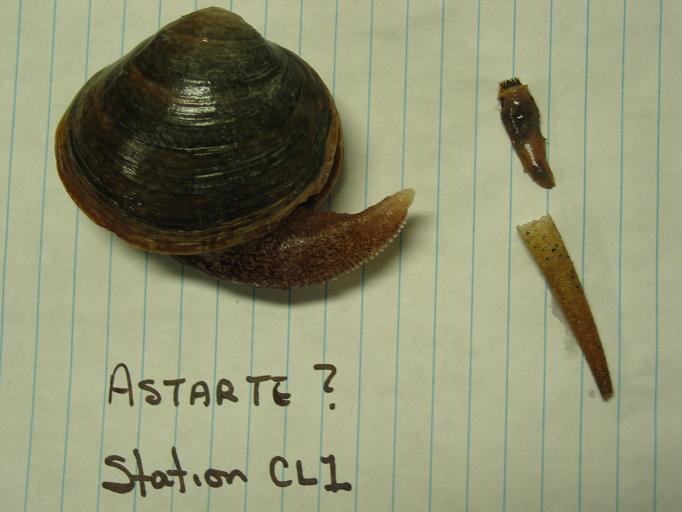
Clams! Some will be used, others won’t. |
Let’s start the report card with some facts. We did a lot:
713 water bottle samples (each one is about 12 liters, or 3 gallons). Lab technicians did tests here, and will do more at home. How many total? 160 CFC’s, 254 cadmium, 570 barium, 325 total carbon dioxide and alkalinity, 77 dissolved organic carbon, 95 dissolved inorganic carbon, 664 nutrients, 238 oxygen, 572 oxygen 18, 709 salinity, 44 iodine 129, 45 cesium 137, and 126 radium 226.
The coring team has 26 meters and 86 centimeters (88ft. 2in) of mud from under the sea floor. It is the farthest north anyone from Oregon State has ever taken a core.
The mooring team placed 23 measuring tools in the ocean to keep track of current, saltiness, temperature, and pressure for the next couple of years.
We have over 3000 nautical miles (5400 kilometers/3300 miles) of sea bottom maps. Most of that is new information.
We also have over 3000 nautical miles of current, temperature, and salinity information.
Almost 100 clams are on ice. They came from 6 meters to 25 meters deep (20-75 feet). About 15 look good enough samples to have their shells tested. The others will be used for practice and for later study.
The trip’s official photographer took 3,600 pictures. The website has over 75 articles about scientific life and ship life. |
| Those are the facts about the trip. However, as Andreas Muenchow said wisely, “A lot of information is not the same as having good information.” Lee Narraway, the photographer added, “It doesn’t mean I have 3,600 great shots.” So, how do we continue the report card? |
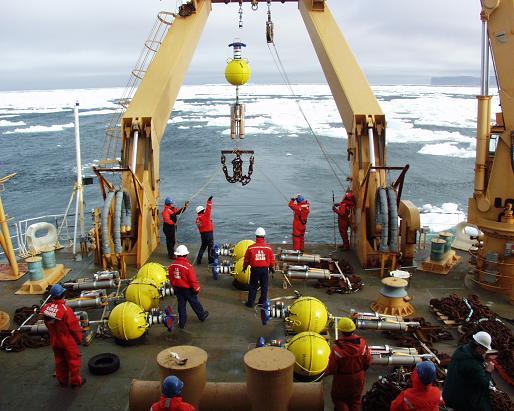
Lots of moorings went down to give information for years to come. |
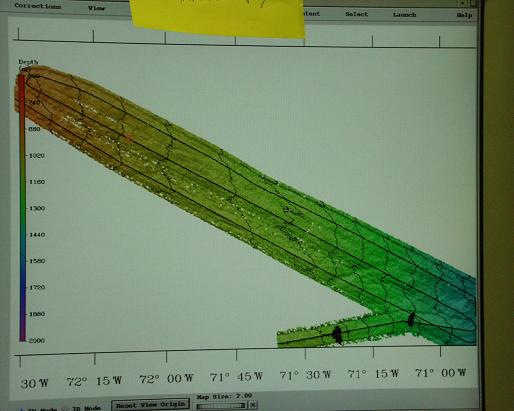
We mapped thousands of miles of sea bottom, current, temperature, and salinity. |
That won’t happen for a long, long time. Humfrey Melling must wait until the spring of 2005 to look at some of the moorings. It is even possible that a mooring might not be there when he returns. Robie Macdonald will take years to examine the clams and collect more information. Kelly Falkner and other chemical oceanographers will study the lab reports for a long time before they learn anything new. Andreas Muenchow already knows that much of the information about currents, temperature, and salinity won’t help him. He must search for the parts that are most useful. This part of the science work will take time. Dr. Macdonald told me his is still studying information he gathered in the 1980’s. |
| One thing I have learned on this trip is a scientist has to think big and has to think about the long term. It is a big job getting this far north. It will take more years of gathering information and studying the information before something is really understood. So, about the report card….you will have to read next year’s web site: CATS 2004, to see how things continue. |
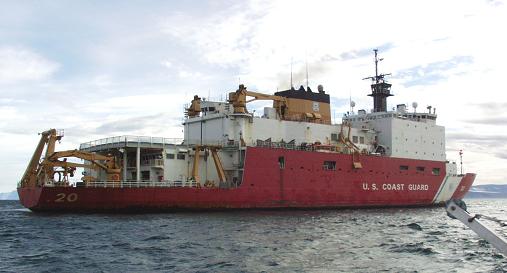
Our home away from home. |
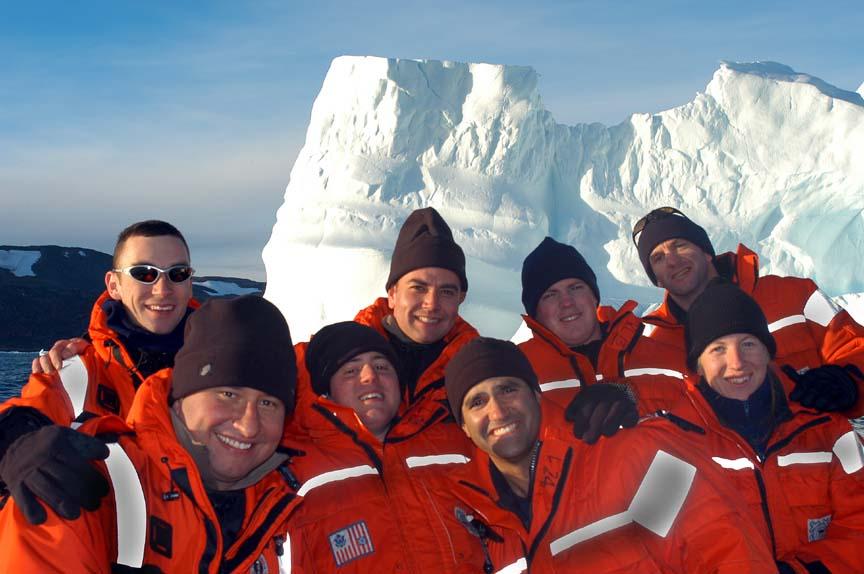
The crew is our lifeline, from diving to doing dishes. |
What else did I learn? Yesterday’s log described the Lifeskills I observed on the trip. I learned, again, how important they are. I also learned, again, how important it is to read and understand graphs, tables, charts, and maps. They are everywhere. I learned first hand that metric is the language of science: water and air are °Centigrade; length is meters and centimeters; volume is liters and milliliters; mass is kilograms and grams; distance is nautical miles or kilometers. I learned about the beauty of the ice and the majesty of the rugged mountains of Greenland and Ellesmere Island. |
| I also learned how lucky I am. Thanks to Kelly Falkner for choosing me to report about the trip. Thanks to the Office of Polar Programs, Arctic Division, at the United States National Science Foundation for funding. Thanks to Captain Oliver of the USCG Healy and all his crew provided: a treadmill, incredible daily meals, questions answered cheerfully, a helo trip, a boat operation, and a safe ship. Thanks to our science crew for teaching me a lot about oceanography in a month. Thanks to Lauren Brown from the University of Delaware for handling the web material. Thanks to Bob McCarthy, my teacher colleague, for his friendship and partnership. Thanks to my wife, Mary, and my children Colleen and Brigid, for supporting me in this adventure. |
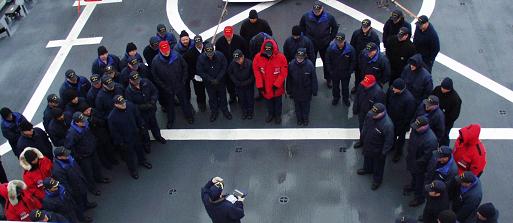
The crew meets every day at “Quarters.” |
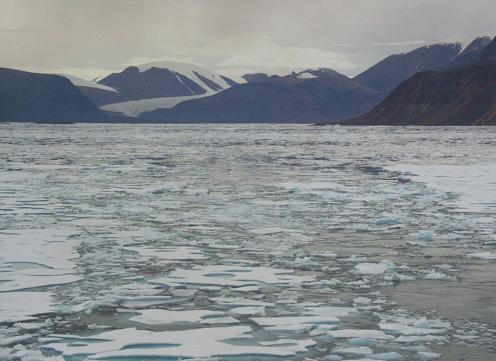
The beauty of the Arctic is stunning. |
Today is our last day on the Healy. Tomorrow we fly from Thule, Greenland to Albany, NY in a military cargo plane, a C-130. No seats, no heat, no protection from the noise. From there, we spread out in different directions for our own homes, our own beds, and our own families. It is a bittersweet day because we are close to going home, but close to leaving such an exciting and interesting place. |
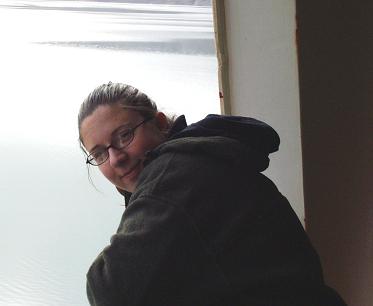
Lauren Brown, the webmaster. |
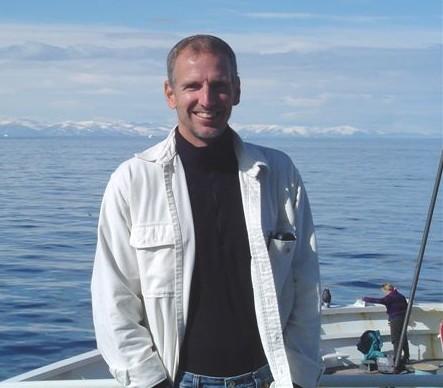
Bob, my journalist partner. |
|
